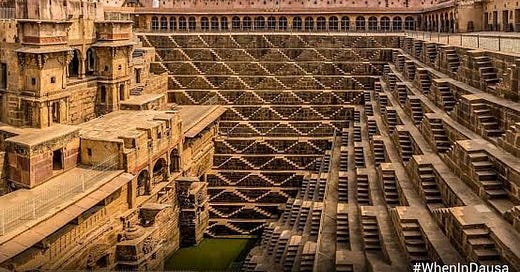🌊 India’s Forgotten Water Marvels: Why Stepwells Are the Answer to Our Climate Crisic
“In the heart of Rajasthan’s desert heat lies a structure that defies time — a stepwell over 1,000 years old, still providing cool shade and fresh water. But how did ancient builders manage this without modern tools? Let’s dive into one of India’s most fascinating architectural secrets.”
🔍 What Is a Stepwell?
Stepwells — or vavs, baolis, or kunds as they’re known across India — are not just wells. They are masterpieces of engineering, social hubs, and sometimes even places of worship.
Imagine walking down a long staircase carved into the earth, surrounded by intricate carvings and shaded walls. As you descend, the air gets cooler. By the time you reach the bottom, you’re standing beside a pool of clean, fresh water — even during the hottest months.
That’s the magic of a stepwell.
Unlike traditional wells, which rely on pulleys and buckets, stepwells were designed with gradual steps leading all the way to the water source. This made it easier for people to access water year-round — even when the water level dropped due to droughts.
But these weren’t just places to get water. Stepwells were also:
Meeting points for villagers
Resting spots for travelers
Cool retreats during summer
Spiritual centers where rituals were performed
And some were so beautiful, they could rival temples.
🏗️ How Did Ancient Indians Build These Marvels?
Let’s take a moment to appreciate the sheer genius behind the design.
First, stepwells were built using locally available stone, often sandstone or marble. Skilled artisans carved every pillar, arch, and stairway by hand — no machines, no electricity.
The layout was carefully planned:
Multi-tiered structures allowed easy access to water at different levels.
Vaulted corridors and pavilions provided shade and cooling.
Intricate carvings depicted gods, goddesses, and celestial beings — turning functional architecture into sacred art.
But here's the real marvel:
many of these stepwells were earthquake-resistant. Builders used interlocking stones and flexible joints that absorbed shocks, allowing them to survive centuries of tremors.
Some had separate chambers for storing rainwater, filtering it naturally through layers of sand and gravel.
Others included wind towers or chhatris (umbrella-like domes) to funnel breezes downward, creating natural ventilation.
This wasn’t just construction — it was climate-resilient architecture before the term even existed.
🧭 Spotlight: Adalaj ni Vav – A Jewel of Gujarat
One of the most stunning examples is Adalaj ni Vav, located just outside Ahmedabad in Gujarat.
Built in 1498 AD during the reign of King Mahmud Begada, this stepwell was commissioned by Queen Rudabai after her husband’s death. It served both as a tribute and as a functional water source.
What makes Adalaj ni Vav special?
It has five levels of descending stairs.
Each floor has pillared corridors and pavilions where people could rest.
The well itself is at the deepest point, accessible only by walking all the way down.
The entire structure is aligned with the cardinal directions, suggesting astronomical planning.
The carvings include Hindu deities like Vishnu, Shiva, and Parvati, along with Islamic floral patterns — showing the cultural blend of the era.
Even today, after more than 500 years, the water remains cool and drinkable.
🕰️ Why Did Stepwells Fall Out of Use?
If these structures were so advanced, why don’t we use them anymore?
There are several reasons:
1. Colonial Infrastructure Shifts
During British rule, new systems like piped water and public pumps were introduced. Stepwells were seen as outdated and fell into disrepair.
2. Neglect and Urbanization
As cities grew, open wells became inconvenient. Many were filled in or turned into garbage dumps.
3. Lack of Maintenance
Without regular cleaning and upkeep, stepwells began to silt up or collapse.
4. Misuse and Pollution
Some were contaminated by waste or misused as dumping grounds.
Today, many stepwells are either partially ruined or completely forgotten.
💡 Modern Revival: Can Stepwells Solve Our Water Crisis?
Here’s an idea that might surprise you: stepwells could be part of the solution to today’s water crisis.
Think about it — stepwells:
Replenish groundwater
Store rainwater efficiently
Need little maintenance once built
Provide passive cooling
Cities like Chennai and Bengaluru are now reviving ancient tanks and stepwells to combat water shortages.
Architects and environmentalists are studying how to integrate stepwell designs into modern buildings, parks, and urban spaces.
Even NASA has studied Indian stepwells for inspiration in designing water systems for Mars!
🧠 Lessons From the Past
Ancient Indians didn’t just build structures — they built systems. Systems that worked with nature, not against it.
They understood:
Water conservation long before it was a buzzword
Passive cooling before air conditioning
Community gathering before social media
Their knowledge wasn’t written in textbooks — it was carved in stone.
So next time you see a baoli or vav, don’t just admire its beauty. Think of the minds that built it. The hands that shaped it. The wisdom passed down through generations.
Because these stepwells are more than history — they are timeless solutions waiting to be rediscovered.
🤔 Want More?
If you enjoyed this post, I’d love to hear from you:
- Have you visited any stepwells?
- Do you think ancient water systems should be revived in modern cities?
- Would you like a downloadable guide of India’s top 10 stepwells?
Drop a comment below or hit reply — let’s keep learning together.
Also, if you're curious about other ancient wonders — like how the Delhi Iron Pillar never rusts, or how temples were aligned with stars — let me know. There’s so much more to explore.
Stay curious,
Ancient Wonders




